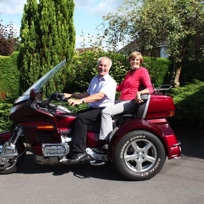( Overview
/ Our Serengeti Safari
We left the Manyara Wildlife Safari Camp at 08:30 and began the steep climb up to NgoroNgoro, stopping en-route to see the view looking back on Manyara.
The Ngorongoro Conservation Area is home to a vast, volcanic crater and “The Big 5” game (elephant, lion, leopard, buffalo, rhino). Huge herds of wildebeests and zebras traverse its plains during their annual migration. Livestock belonging to the semi-nomadic Maasai tribe (who are the only people allowed to live in the area) graze alongside wild animals. Fossils of early humans found in the Olduvai Gorge date back millions of years.
We drove on through NgoroNgoro seeing lots of Massai vilages along with Wildebeest, Giraffe, Storks, Thomson's Gazelles, Hippopotami, Elands and Tawny Eagles.
Around midday, we arrived at Olduvai Gorge which is an archaeological site in the eastern Serengeti Plain, within the boundaries of the Ngorongoro Conservation Area. Deposits exposed in the sides of the gorge cover a time span from about 2.1 million to 15,000 years ago. The deposits have yielded the fossil remains of more than 60 hominins (members of the human lineage), providing the most continuous known record of human evolution during the past 2 million years, as well as the longest known archaeological record of the development of stone-tool industries.
The British / Kenyan paleoanthropologist Louis Leakey and his wife Mary worked here for many years and there is a small museum & exhibition showing the work of the Leakeys and others.
We sat in the exhibition centre and ate our packed lunch, at which point the sole of Hulley's other trainer fell off and the pair were thrown away, leaving him wearing flip-flops !
Before leaving, we watched a short film about the work which was undertaken at Olduvai and how it changed the perception of how humans evolved.
Next we entered the Serengeti plain which seems to stretch out long and flat for mile after mile. Here we saw more Wildebeest, Zebras, Gazelles, Giraffes, Eagles and a number of Hippopotami, lying in a mud-bath, occasionally turning over making terrible smells !
On the way to the Ndutu Kati tented camp, we made a short stop at a Hot Air Balloon Centre as Natalie and Mel planned to do a flight next morning.
The tent was quite luxurious with a double bed, flush toilet and a shower, enabled by a man bringing a bucket of hot water and hoisting it up to the top of our tent. This is our kind of camping !
After our shower, we sat outside by a big fire, having a drink with the other guests and watching the sunset. A very pleasant evening and dinner then an early night as it had been a long day and tomorrow we have to be up at 05:30 in order to see the Serengeti at its best.
The Ngorongoro Conservation Area is home to a vast, volcanic crater and “The Big 5” game (elephant, lion, leopard, buffalo, rhino). Huge herds of wildebeests and zebras traverse its plains during their annual migration. Livestock belonging to the semi-nomadic Maasai tribe (who are the only people allowed to live in the area) graze alongside wild animals. Fossils of early humans found in the Olduvai Gorge date back millions of years.
We drove on through NgoroNgoro seeing lots of Massai vilages along with Wildebeest, Giraffe, Storks, Thomson's Gazelles, Hippopotami, Elands and Tawny Eagles.
Around midday, we arrived at Olduvai Gorge which is an archaeological site in the eastern Serengeti Plain, within the boundaries of the Ngorongoro Conservation Area. Deposits exposed in the sides of the gorge cover a time span from about 2.1 million to 15,000 years ago. The deposits have yielded the fossil remains of more than 60 hominins (members of the human lineage), providing the most continuous known record of human evolution during the past 2 million years, as well as the longest known archaeological record of the development of stone-tool industries.
The British / Kenyan paleoanthropologist Louis Leakey and his wife Mary worked here for many years and there is a small museum & exhibition showing the work of the Leakeys and others.
We sat in the exhibition centre and ate our packed lunch, at which point the sole of Hulley's other trainer fell off and the pair were thrown away, leaving him wearing flip-flops !
Before leaving, we watched a short film about the work which was undertaken at Olduvai and how it changed the perception of how humans evolved.
Next we entered the Serengeti plain which seems to stretch out long and flat for mile after mile. Here we saw more Wildebeest, Zebras, Gazelles, Giraffes, Eagles and a number of Hippopotami, lying in a mud-bath, occasionally turning over making terrible smells !
On the way to the Ndutu Kati tented camp, we made a short stop at a Hot Air Balloon Centre as Natalie and Mel planned to do a flight next morning.
The tent was quite luxurious with a double bed, flush toilet and a shower, enabled by a man bringing a bucket of hot water and hoisting it up to the top of our tent. This is our kind of camping !
After our shower, we sat outside by a big fire, having a drink with the other guests and watching the sunset. A very pleasant evening and dinner then an early night as it had been a long day and tomorrow we have to be up at 05:30 in order to see the Serengeti at its best.

 Sign in with Apple
Sign in with Apple  Log in with Facebook
Log in with Facebook